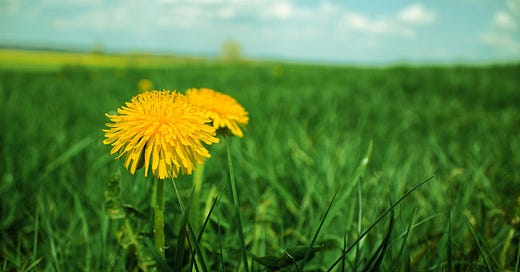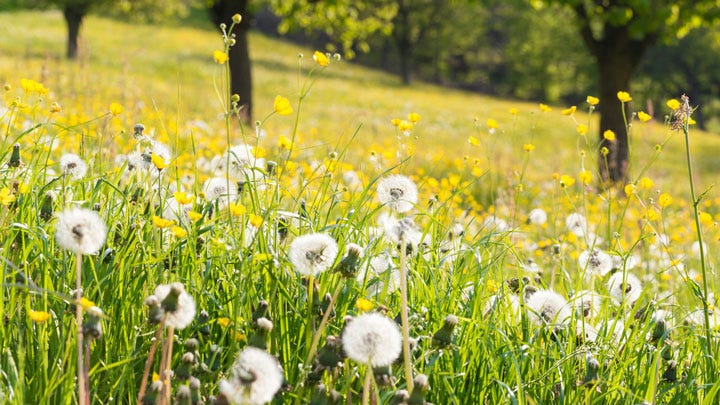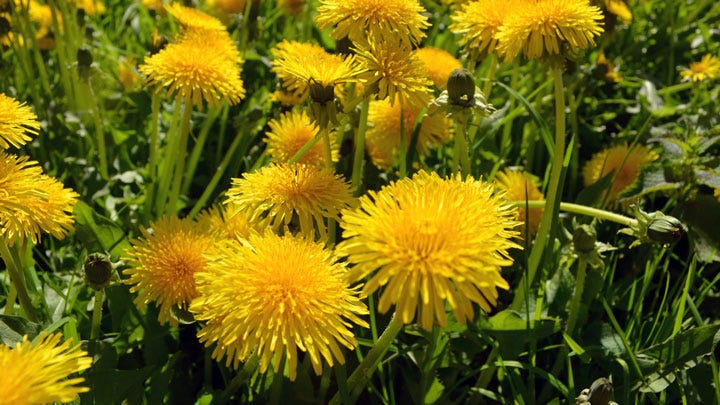Herbal Thursday: Dandelion
Dandelions: Wacky Weed or Nature's Nourishment? Discover why this plant is not the bane of your lawn but the boon of your table.
Finding herbs with great benefit doesn’t have to come at a high cost. You don’t have to travel the world or look in the most unlikely places. In fact, some of the best herbs may be growing right in your own backyard. Meet the king of the suburban landscape: the dandelion.
In the Northern Hemisphere, we are in the midst of the long summer season. For those who keep a grass lawn, this is also the season of frustration. Why? Because those little, yellow, puffy flowers with their puffier, silver seed balls so successfully break up the carpet-like appearance of a stereotypical suburban yard.
Yet we prefer gorilla gardening and use the “lawn” to grow the best-ever foods and herbs. So a grass lawn isn’t really a option. But if it is for you, then at least find a corner tucked away to let the dancing dandelion have a home.
Please Note: Dandelions are often the first food of Spring for bees gathering pollen and for seed-eating birds.
Enter: The Dandelion
The dandelion, believed to be one of the most prolific weeds in the US, is a wild herb that feels more welcome in its homeland of Europe than in the States. In Switzerland, for instance, you may still find fields of dandelions — where they’re viewed with gratitude, not scorn. Here…
Dandelions are members of the Asteraceae family of plants, which includes daisies, asters, and even feverfew. The plant has large lobed leaves that create a circular pattern and a long, hollow stalk that produces one yellow flower. The trouble with this weed — if you want to call it that — is the long taproot, which can go down 2 feet. (1)
Please Note: If you have a latex allergy, then you may want to steer clear. The milky sap of the stem has latex in it. (2)
The best way to manage dandelions without chemicals is by pulling up the taproot. But you’d better get it all, because new plants can shoot off from even a small piece of root left in the ground. (2)
On the other hand, dandelions do help the soil by breaking up hard and compacted ground, making it easier to grow other grasses and herbs. And while this herb was maligned for years, you can now find fresh leaves sold in the grocery store. In fact, all parts of the plant are edible — and we’ll talk about foraging below.
All parts of the dandelion plant are edible!
Probably what surprises people the most is not that you can eat dandelions, but that you actually want to eat dandelions.
Dandelion Benefits
Dandelion leaves, or “greens” are actually more nutritionally potent than the lettuce you have in your crisper. They contain just as much iron as spinach, and four times as much provitamin A (beta carotene) as the popular salad green.
One cup of dandelion greens also contains 535% of the recommended daily allowance of vitamin K and is a good source of vitamin C, calcium, iron, fiber, and potassium! (3)
The plant, also a known diuretic, works to increase the amount of urine the body produces and can be valuable in reducing water weight or blood pressure. It also has digestive benefits, working as a mild appetite stimulant and settling an inflamed GI tract.
Historically and to this day, the leaves are most widely recognized as a promoter of liver health, as they stimulate the production of bile and work to detoxify the blood.
Though not much research funding goes to wild herbs and weeds, some studies do analyze the benefits of this particular wild herb. (4)
Here are a few researched health benefits of the humble dandelion:
1. Antioxidant and Anti-Inflammatory Properties
As noted, dandelions rank high on the scale of antioxidant capacity, offering a full complement of polyphenols, vitamins, and minerals. This little herb is actually quite high in Vitamin C, but remember that heat destroys vitamin C. So if you can choke down the bitterness, you’ll get a good dose of micronutrients. (5)
Of course, you can wilt the leaves, keeping many of vitamins intact. And by adding a fat, you’ll enjoy the benefits of the fat soluble vitamins, especially Vitamin K.
2. Promotes Healthy Digestion
What about those bitters?
Bitter foods signal several processes in the body, all of which will benefit your health. From stimulating the flow of bile — digest those fats! — to reducing bloating and digestive discomfort, bitter greens like dandelion promote the regular flow of digestion and elimination. Also, by stimulating bile and stomach acid, your body will better absorb nutrients from your food, leading to better overall health. (6)
In additions, this wild herb has compounds that reduce inflammation along the digestive tract. Dandelions help with stomach upset caused by acid reflux, ulcerative colitis, and small intestinal ulcers. (7)
3. Supports Liver Health
The liver is your master detox organ. Fortunately, this lawn herb supports
4. Protects Against Cancer
What is most likely to protect you from cancer?
The quality of life of any living being is based on two key elements: on the one hand, survival, which is qualitative, and on the other hand, longevity, which is quantitative. Both properties are intimately linked to the quality of food… (7)
Researchers have identified polyphenols in every part of the dandelion herb that promote health, encouraging apoptosis (programmed cell death — a good thing) and preventing cancer growth. Specifically, polyphenols and micronutrients help to detoxify the body to protect it from developing tumors and even reverse tumor growth. (8, 9)
5. Promotes Healthy Metabolism
Oxidative stress impacts the body in a myriad of ways, including metabolism. Metabolic Syndrome relates to the body’s ability to utilize nutrients, maintain healthy blood sugar levels, and eliminate metabolic waste. Dandelions help in all these areas. In particular, the antioxidants relieve oxidative stress and reduce inflammation. As a diuretic, excess fluid will be flushed out, further helping with blood sugar levels. (10)
Enjoy this informative video! 👇
Foraging Dandelion
Dandelion is one of the most abundant plants out there. It can be found popping up in lawns and gardens — even out of the cracks in sidewalks. That being said, you do not want to pick just any dandelion. Any plant will take nutrients from the soil, so select herbs growing in a diverse environment with quality soil. “Weeds” on the side of the road may have contamination from car exhaust, tires, oil, or gasoline. And inviting lawns may conceal pesticides or herbicides that will have been absorbed up by the roots and leaves.
Believe it or not, the entire plant is edible:
Flowers: An excellent source of antioxidants, used in cooking and baking.
Leaves: Used in teas, tinctures, and meals.
Roots: Used in liver tonics, teas, and tinctures.
Here’s what to look for: (11)
Flowers: Choose the full and bright yellow blossoms. Can be foraged all year long, but it’s best to collect early in the day, while the flowers are still open and before the bright sun has wilted them.
Leaves: Choose a mixture of young and older leaves. The older and larger the leaf, the more bitter and tough it can be. Can also be foraged all year long, but the smaller leaves that first emerge in Spring may be less bitter.
Roots: Choose roots from a fully developed plant, which will have a large root system. It is best to forage the roots in springtime. The roots can be dried and roasted as a coffee replacement.
As with all wild plants, it is important to harvest responsibly. This means, not taking more than you need or completely clearing out the whole area. If you can, find a bunch of them and thin them out a bit. Of course, leave some for Mother Nature to do her thing.
Ways to use Dandelion
Medicinal and edible, the dandelion is very nutritious, having more vitamins and minerals than most vegetables. It has a long history of use as a food and medicine in many countries.
Use the greens in salads, detox juices and smoothies, stir fries, soups and sautés. You can also make a detox tea from the leaves. Try a wild dandelion pesto, using the leaves, hemp seeds, garlic, sea salt, and olive oil. It’s divine!
The flowers can be added to salads but are more often used in teas — like chamomile is. They also may be dipped in batter and fried. The roots make an awesome coffee substitute when dried and roasted. Dandelion wine is made from fermented flowers and is very flavorful and medicinal! Many of the research studies cited use an extract of dandelion leaves and roots.
Check out this creative recipe, adapted from EatTheWeeds.com.
Cream of Dandelion Soup
Recipe adapted from: http://www.eattheweeds.com/dandelions-hear-them-roar/
Ingredients:
4 cups chopped dandelion leaves
2 cups dandelion flower petals
2 cups dandelion buds
1 Tbsp grass-fed ghee or organic coconut oil
1 cup chopped wild leeks (or onions)
6 cloves garlic, minced
4 cups spring water
1 cups raw cashews, soaked
2 tsp sea salt
Preparation:
Gently boil dandelion leaves in 6 cups water. Pour off the bitter water. Boil gently a second time, pour off the bitter water.
In a heavy-bottom soup pot, sauté wild leeks and garlic in ghee or oil until tender.
Add 4 cups spring water.
Add dandelion leaves, flower petals, buds, and salt.
Simmer gently 45 minutes or so.
Add cashews and simmer a few minutes more.
Blend in a high-powered blender such as NutriBullet Rx.
Garnish with flower petals.
For additional tips on cooking dandelions, see this video: 👇
These statements have not been evaluated by the Food and Drug Administration. This information is not intended to diagnose, treat, cure, or prevent any disease.
Join the David Avocado Wolfe Substack Community
This is where transformation begins — are you ready to join us?
Wolfe University
Ready to go all-in? Experience the new Wolfe University with both free and paid courses, as well as the platform for David Wolfe's Inner Circle.
David Avocado Wolfe Links
David Wolfe Website: https://www.davidwolfe.com/
Wolfe University: https://university.davidwolfe.com/
David Wolfe Shops
US: https://shop.davidwolfe.com/
UK: https://davidwolfe.uk/
Our favorite Chocolate Factory is now located in Central Florida! Please visit Butler’s Raw Chocolates! 2400 South Hopkins Avenue, Unit E, Titusville, FL 32780
Butler’s Raw Chocolates: https://butlersrawchocolates.com/
Links on this page may be affiliate links; any proceeds support the work of David Avocado Wolfe.
This post was not AI generated.





